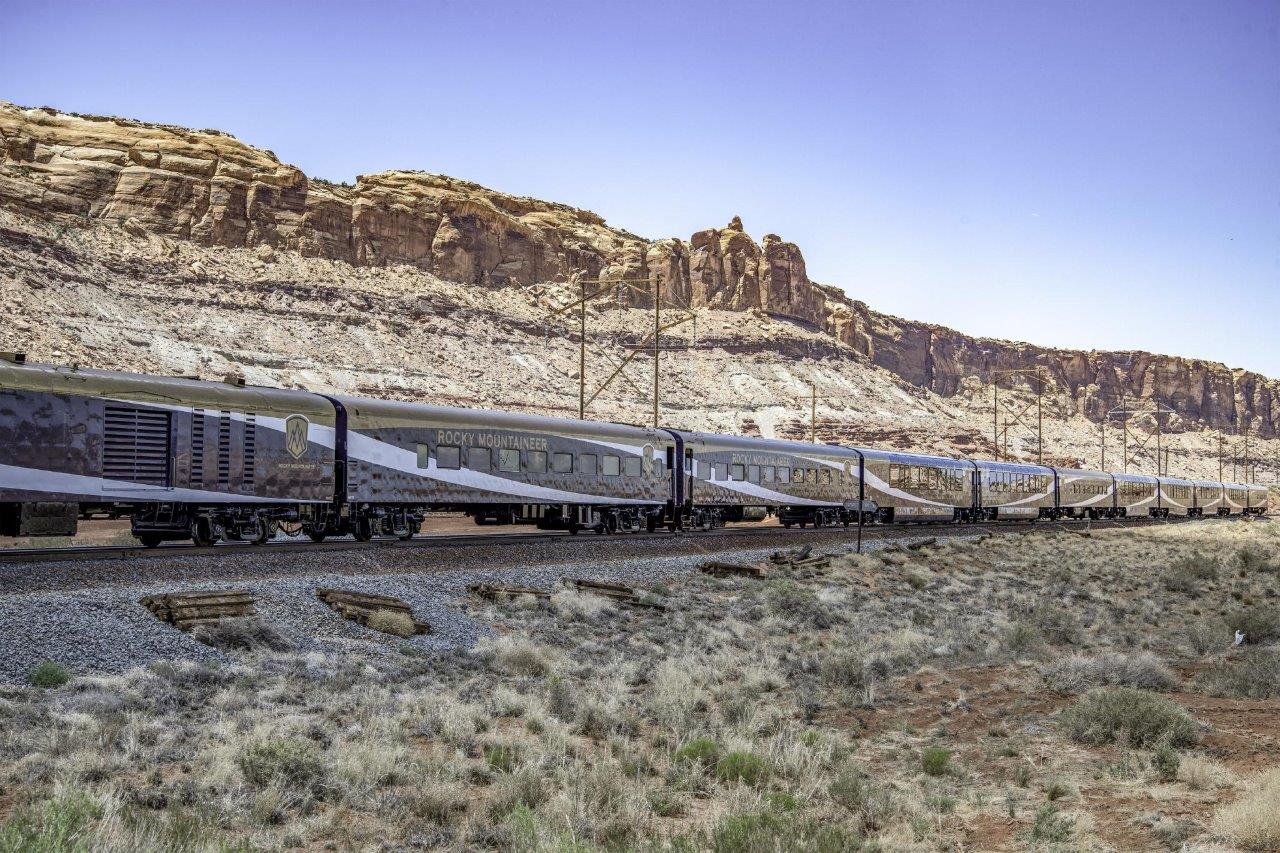Visions of towering rosy hoodoos, pillowy sandstone hills, and sheer-sided box canyon walls were on my mind as I climbed aboard the Rocky Mountaineer just outside of Denver. For two days we’d be rolling along historic rail lines and tracking the muddy Colorado River from Denver to Moab, Utah, covering 563 kilometres at a leisurely average of 40 miles per hour.
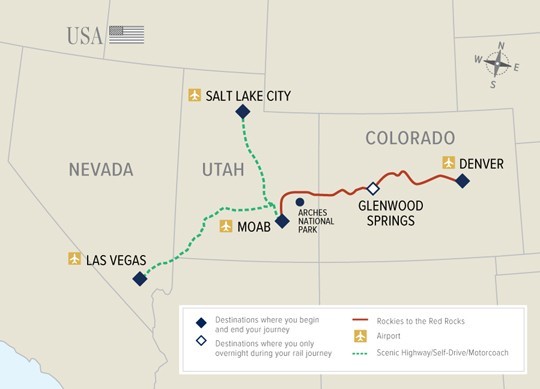
Red Rocks to the Rockies Route – photo Rocky Mountaineer
The Rockies to the Red Rocks route is the first foray for Canadian-based Rocky Mountaineer into the US. The company offers three other daytime routes through the rugged Canadian Rockies from Vancouver to Jasper, and they’ve had time to perfect every detail of the luxury train travel experience.
Detours in Denver
Our trip started in Denver with a visit to Union Station. After a 54 million dollar renovation, the 1881 Beaux-Arts station has blossomed into much more than a transportation hub. The Terminal Bar serves 30 made-in-Colorado craft beers where the ticket booth once stood. Now, several award-winning fine dining and casual restaurants surround the soaring 65-foot glass-fronted Great Hall, and the train-travel inspired Crawford Hotel fills the upper floors. With sparkling cocktails in hand, we had an excellent view of the hubbub in the atrium from the sophisticated Cooper Lounge on the mezzanine.
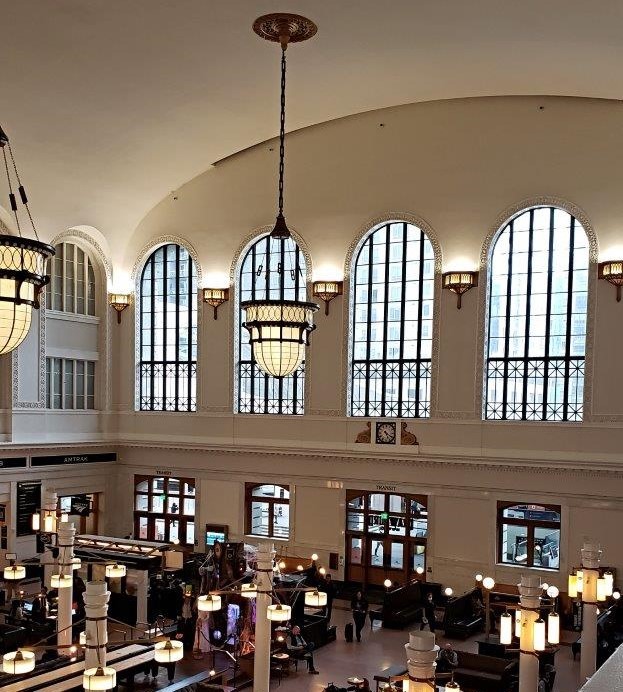
The Great Hall at Union Station in Denver – photo Debra Smith
Rocky Mountaineer offers an overnight stay at several boutique hotels in downtown Denver including The Crawford. There is no sleeper car on the train, but passengers have a choice of nightly accommodations. The historic Oxford has a stunning Art Deco lounge called The Cruise Room (open continuously since Prohibition was repealed), while The Maven is a former Windsor Dairy building turned trend-setting hotel in the Dairy Block that hosts over two dozen eateries, plus several bars, bakeries, shops, and galleries.
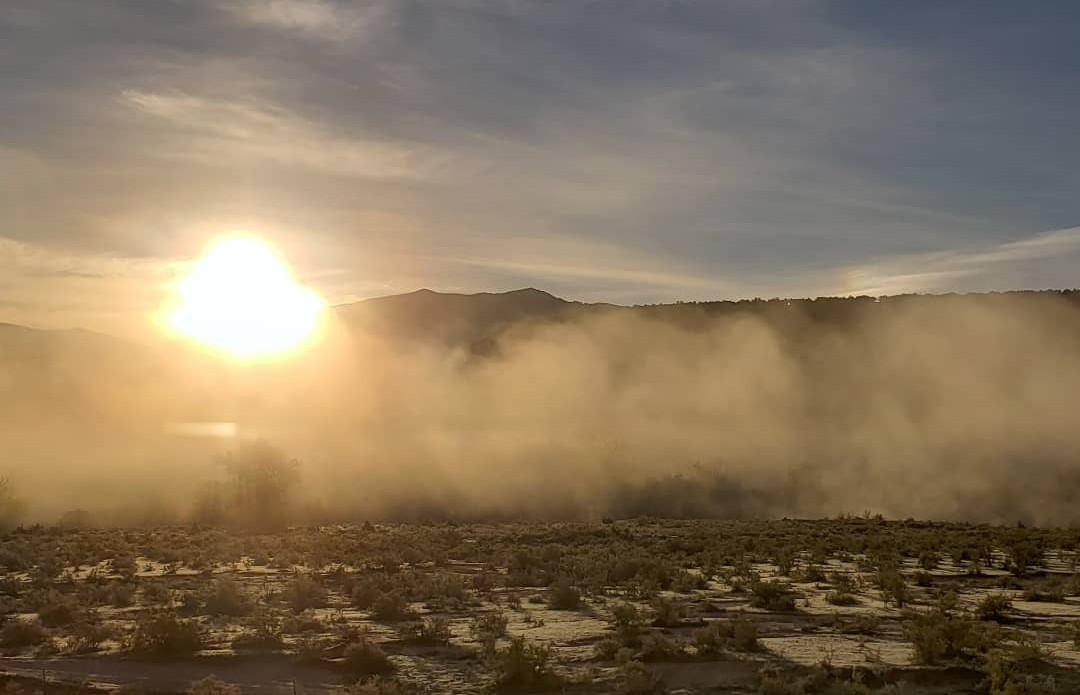
Morning fog rises from the Colorado – photo Debra Smith
Morning in the Mile High City
Early the following day, we left our tagged luggage in the tender care of the Rocky Mountaineer staff and boarded a motorcoach that would take us to the train. Our bags would be waiting in our rooms at each hotel. We found our car, met our hosts for the trip, and settled back in our assigned seats. The engine whistled, and the train glided silently out of the siding. There’s no clickety-clack on this trip: the rail joints are welded, reducing track noise to a whisper.
SilverLeaf coaches have panoramic glass-domed windows, lightly tinted to keep out the heat. As a result, they don’t interfere with picture taking, which is the main activity on this trip for most people. My fellow guests were a mix of newlyweds, retirees, and train aficionados who were jonesing to be among the first to travel the new route.
Our plush, caramel coloured pleather chairs had plenty of legroom and adjustments to allow for tray tables. Unlike the Canadian routes, there is no separate dining car, but we were quickly presented with a breakfast menu, white cloth napkins, and sparkling utensils. Speaking of meals, it was impressive that our hosts were able to produce a selection of hot and cold dishes for breakfast, and three-course lunches, from a kitchen the size of a walk-in closet, all the while refilling wine glasses and coffee cups and keeping up a running commentary. There were frittatas, pancakes and parfaits for breakfast, and coriander crusted coho salmon or honey-roasted pork loin at lunch, along with hors d’oeuvres and delicious desserts.
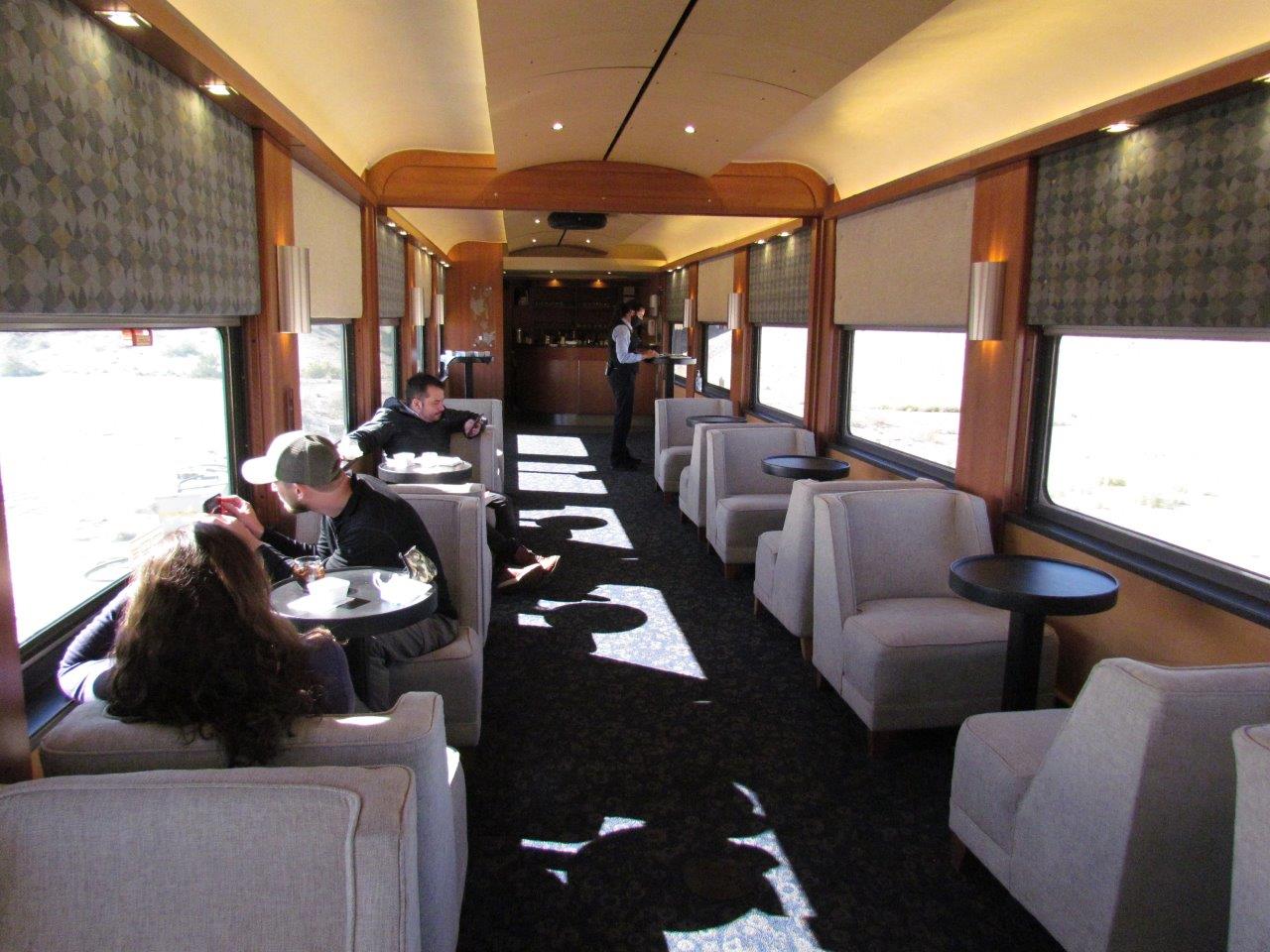
The Art Deco bar car on the Rocky Mountaineer – photo Debra Smith
Tons of Tunnels
As we were about to discover, there is a good reason there are no two-level dome cars on these coaches. We were about to squeeze through 30 tunnels with seemingly only inches to spare along a 13 mile stretch of track built-in 1904.
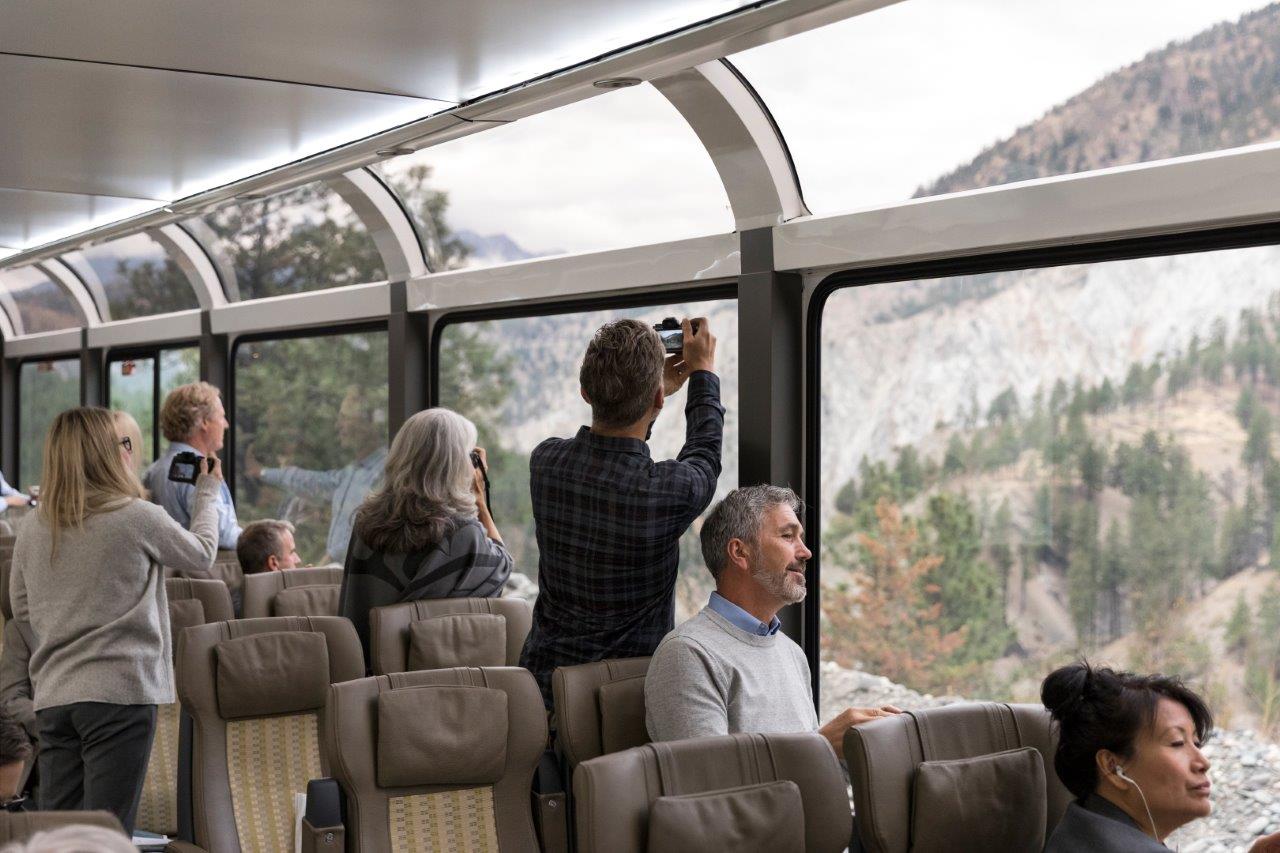
Silverleaf coaches have generous windows for great photographs – Rocky Mountaineer
One of four hosts, Mike, recounted how Denver financier David Moffat, furious that the transcontinental railroad bypassed Denver, swore to go “through the Rockies, not around them”. He never lived to see it, but the 6.2-mile-long Moffat Tunnel was blasted through the Continental Divide in 1928, making it the 6th longest tunnel in the world at that time. As we sailed into the black tunnel, overhead lights kept the cabin brightly lit until we popped out into the sunlight again.
Just past the Moffatt Tunnel, the track began to parallel the Colorado River, and we glimpsed the first of many canyons that the river had carved away – the Byers, Gore and Burns. Little by little, the landscape changed from a sandy wash to pale rose-coloured cliffs, slashed through by valleys filled with Douglas fir, Ponderosa pine and junipers. Along the way, Mike alerted us to upcoming photo ops and sightings of pronghorn and eagles.
Canyons carved by the Colorado River
Just past the Dotsero cutoff, where the Eagle River meets the Colorado, we reached Glenwood Canyon. Here the 1,300-foot (400 m) canyon walls turn vertical. Standing in the open gangway between the coach and the bar car, it seemed entirely possible, but unadvisable, to reach out and touch them. This is one of the largest and most scenic canyons in the US and almost impossible to photograph from the train, but it was worth a try. The wind whipped through the open window as shadows from the rockface flicked away the sunlight, and we took turns at the window gamely, snapping away with cameras and phones. Afterwards, we headed to the Art Deco bar car. It was a pleasure to relax by the window with a glass of wine and watch the train wind its way along the tracks. Unlimited beverages, cocktails and wine are among the perks of SilverLeaf Plus.
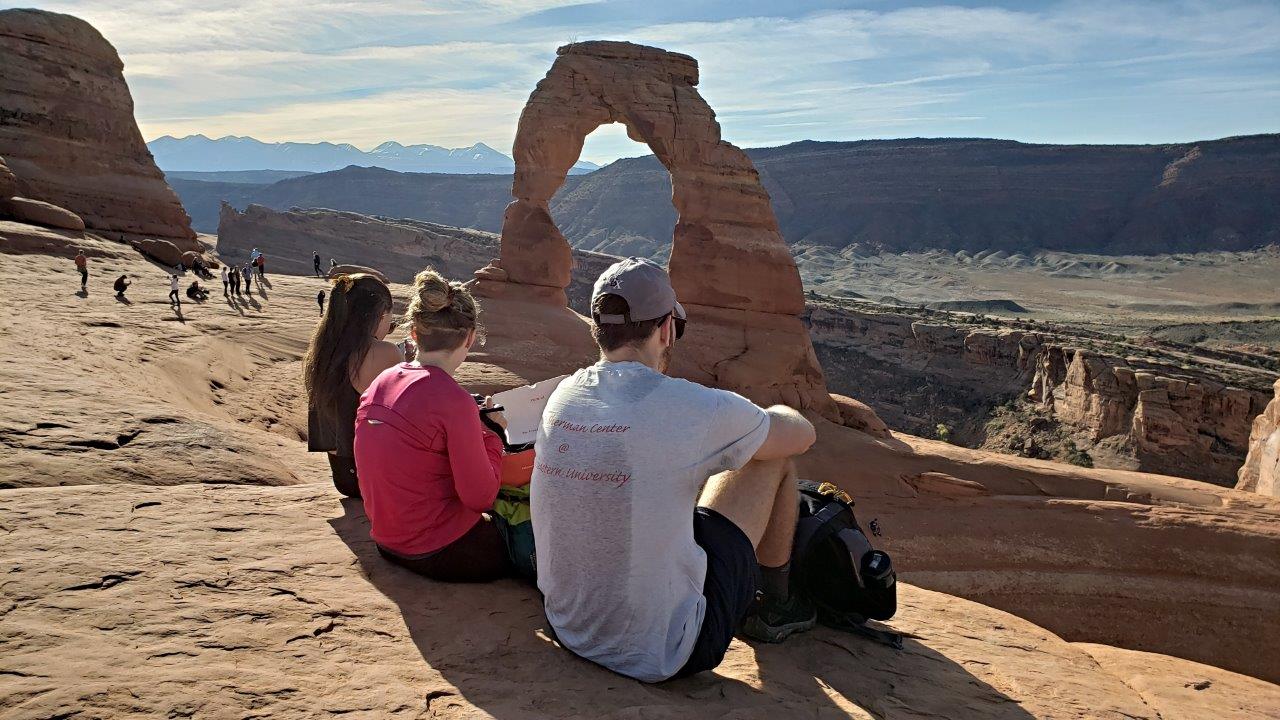
Delicate Arch at Arches National Park – photo Debra Smith
Getting Hot in Glenwood Springs
Soon we were rolling into Glenwood Springs, the halfway point of our journey. As our bags were transferred, we had time to stroll over the bridge that connects downtown with most of the hotels in town. It was sunset, and we had a good view of the largest geothermal hot springs in the world, the Spa of the Rockies at the Glenwood Hot Springs Resort. The pool is open every day until 9 pm so there was plenty of time for a dip under the starry Colorado sky before heading to the Riviera Scratch Kitchen for a memorable pasta dinner.
The town of Glenwood Springs (pop. 9,900), has a long association with outlaws and showmen dating back to the days of Buffalo Bill. Doc Holliday came to Glenwood Springs hoping for a miracle cure, but it eluded him, and he’s buried somewhere in Linwood Cemetery. It’s a steep uphill climb to find his marker that’s covered in playing cards and coins. After the mineral springs were discovered in 1888, they were developed into a European style spa and casino that attracted celebrities, gamblers and, later, criminals like Al Capone. These days it’s a family-friendly playground with splash pools and water chutes.
Early the following day we boarded our train in the dark and were treated to the sight of the sun tinting the Book Cliffs gold and illuminating the snow-covered peak of Mount Garfield, the highest peak in the range at 6,765 feet (2,061 m). The cliffs would follow us through the De Beque Canyon and into Palisade, a town famous for peaches and the epicentre of Colorado’s wine country. When we entered Ruby Canyon, the train slowed down so we could appreciate the deep orange and beet red sandstone cliffs lining the Colorado. This part of the river can’t be reached by car, but it’s still popular with rafters, who took the opportunity to give a pantless “Colorado salute” to the train as it went by. With that, we said goodbye to Colorado and crossed the state line into Utah. A white sign painted high on the canyon walls marks the border.
Goodbye Train, Hello Canyon Adventures
Between Ruby Canyon and Moab, we crossed into true Wile E. Coyote territory. The hoodoos were taller, the rock layers seemed more precariously stacked, and the golden and rusty red sandstone layers jockeyed for space on the mountainsides. We were nearing the end of our journey, passing by the awe-inspiring spires of Arches National Park, one of the Mighty 5 national parks: Arches, Bryce Canyon, Canyonlands, Capitol Reef, and Zion.
We ended our rail journey near Moab and left our train with real regret. It had been two days of unplugged pleasure, no cell phone reception, wonderful meals, entertaining hosts, and a landscape that shape-shifted over the course of the two days. Every turn in the track led to another spectacular view. While our companions headed into Moab, we took a tour of a corner of Canyonlands National Park with its endless vistas, crenellated towers, and perilously perched boulders. It was a sweet ending to our slow trip through the west.
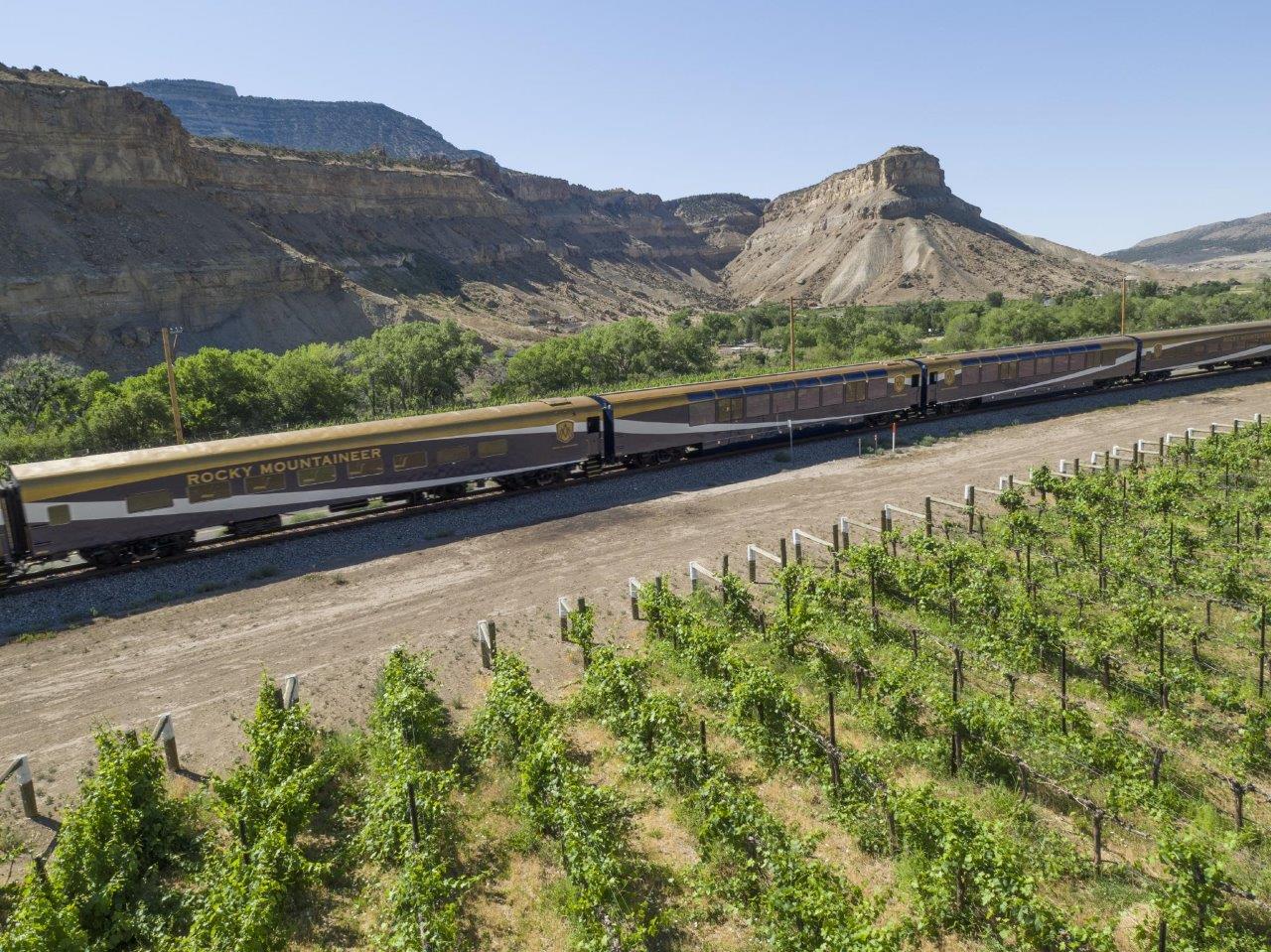
Rolling through the vineyards near Palliser – photo Rocky Mountaineer
Into the West
For those who want to explore more of this magical American landscape, Rocky Mountaineer partners with Southwest Adventure Tours to take visitors into Canyonlands and Arches Parks and beyond. Trips can be customized beyond the two-day rail trip to include additional activities like river rafting, hiking, and helicopter tours. Try a Hell’s Revenge Sunset Tour with Outlaw Adventure Tours for some heart-stopping off-roading or stargaze in the blue Utah night with Moab Astronomy Tours. The new Hoodoo Moab Curio Collection by Hilton with its mining theme, original artwork and outdoor pool makes a fine home base. Connections can also be arranged with Salt Lake City and Las Vegas.
The writer was a guest of Rocky Mountaineer. As always, her opinions are her own. For more photos of this trip, follow her on Instagram @Where.To.Lady

